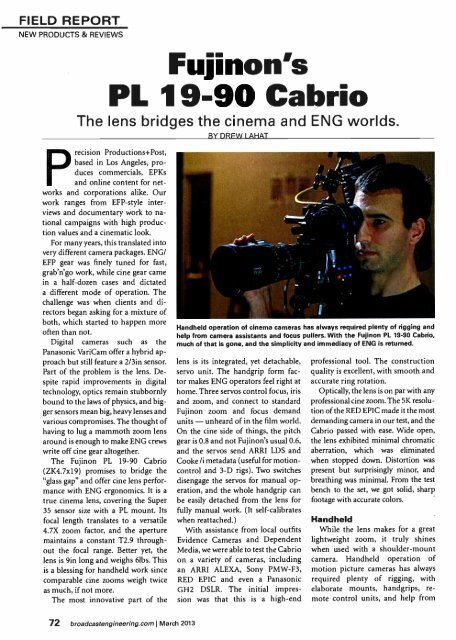ßroadcastEnsineerin - AmericanRadioHistory.Com
ßroadcastEnsineerin - AmericanRadioHistory.Com
ßroadcastEnsineerin - AmericanRadioHistory.Com
Create successful ePaper yourself
Turn your PDF publications into a flip-book with our unique Google optimized e-Paper software.
FIELD REPORT<br />
NEW PRODUCTS & REVIEWS<br />
Fujinon's<br />
PL 19 -90 Cabrio<br />
The lens bridges the cinema and ENG worlds.<br />
BY DRFW LAHAT<br />
recision Productions+Post,<br />
based in Los Angeles, produces<br />
commercials, EPKs<br />
and online content for networks<br />
and corporations alike. Our<br />
work ranges from EFP -style interviews<br />
and documentary work to national<br />
campaigns with high production<br />
values and a cinematic look.<br />
For many years, this translated into<br />
very different camera packages. ENG/<br />
EFP gear was finely tuned for fast,<br />
grab'n'go work, while cine gear came<br />
in a half -dozen cases and dictated<br />
a different mode of operation. The<br />
challenge was when clients and directors<br />
began asking for a mixture of<br />
both, which started to happen more<br />
often than not.<br />
Digital cameras such as the<br />
Panasonic VariCam offer a hybrid approach<br />
but still feature a 2 /3in sensor.<br />
Part of the problem is the lens. Despite<br />
rapid improvements in digital<br />
technology, optics remain stubbornly<br />
bound to the laws of physics, and bigger<br />
sensors mean big, heavy lenses and<br />
various compromises. The thought of<br />
having to lug a mammoth zoom lens<br />
around is enough to make ENG crews<br />
write off cine gear altogether.<br />
The Fujinon PL 19 -90 Cabrio<br />
(ZK4.7x19) promises to bridge the<br />
"glass gap" and offer cine lens performance<br />
with ENG ergonomics. It is a<br />
true cinema lens, covering the Super<br />
35 sensor size with a PL mount. Its<br />
focal length translates to a versatile<br />
4.7X zoom factor, and the aperture<br />
maintains a constant T2.9 throughout<br />
the focal range. Better yet, the<br />
lens is 9in long and weighs 6lbs. This<br />
is a blessing for handheld work since<br />
comparable cine zooms weigh twice<br />
as much, if not more.<br />
The most innovative part of the<br />
Handheld operation of cinema cameras has always required plenty of rigging and<br />
help from camera assistants and focus pullers. With the Fujinon PL 19 -90 Cabrio,<br />
much of that is gone, and the simplicity and immediacy of ENG is returned.<br />
lens is its integrated, yet detachable,<br />
servo unit. The handgrip form factor<br />
makes ENG operators feel right at<br />
home. Three servos control focus, iris<br />
and zoom, and connect to standard<br />
Fujinon zoom and focus demand<br />
units - unheard of in the film world.<br />
On the cine side of things, the pitch<br />
gear is 0.8 and not Fujinon's usual 0.6,<br />
and the servos send ARRI LDS and<br />
Cooke /i metadata (useful for motion -<br />
control and 3 -D rigs). Two switches<br />
disengage the servos for manual operation,<br />
and the whole handgrip can<br />
be easily detached from the lens for<br />
fully manual work. (It self -calibrates<br />
when reattached.)<br />
With assistance from local outfits<br />
Evidence Cameras and Dependent<br />
Media, we were able to test the Cabrio<br />
on a variety of cameras, including<br />
an ARRI ALEXA, Sony PMW -F3,<br />
RED EPIC and even a Panasonic<br />
GH2 DSLR. The initial impression<br />
was that this is a high -end<br />
professional tool. The construction<br />
quality is excellent, with smooth and<br />
accurate ring rotation.<br />
Optically, the lens is on par with any<br />
professional cine zoom. The 5K resolution<br />
of the RED EPIC made it the most<br />
demanding camera in our test, and the<br />
Cabrio passed with ease. Wide open,<br />
the lens exhibited minimal chromatic<br />
aberration, which was eliminated<br />
when stopped down. Distortion was<br />
present but surprisingly minor, and<br />
breathing was minimal. From the test<br />
bench to the set, we got solid, sharp<br />
footage with accurate colors.<br />
Handheld<br />
While the lens makes for a great<br />
lightweight zoom, it truly shines<br />
when used with a shoulder -mount<br />
camera. Handheld operation of<br />
motion picture cameras has always<br />
required plenty of rigging, with<br />
elaborate mounts, handgrips, remote<br />
control units, and help from<br />
72 broadcastengineering.com March 2013
















